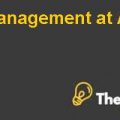
Abstract
The paper discusses the core concepts of change management and identifies the key methods and significance of the change process. Moving ahead in the paper, it also describes the implementation phase of the process and why it is considered an important phase. Secondly, the role of management, culture and employees is also discussed during the paper and how they impact the change and the change process. Furthermore, the paper will provide the complete list of the phases of the change and types of change and their occurrence along with an overview of the models that are used in implementing the change. This paper has also shed light on the significance of leadership and its importance in implementing a change successfully and the impact it has on the Generation Y. Generation Y has been discussed as a difficult generation to manage for the modern business world leaders but also guides that how leaders can attract employees from Generation Y and manage and influence them. This report has used different journal articles and conducted an external research method to gather data and conclude the result. The resources from which the research has been conducted are authentic and are accepted worldwide.
Key words: Change management, Leadership, Generation Y
Introduction
Leadership is often confused with management and considered as the backbone of an organization. It is imperative for a leader to bring changes within a company. Leaders have the broader vision for the long term and view things from a more holistic and bird view aspect while the managers are the ones who translate that vision into practice. There is no specific definition of leadership, but one famously quoted is by Porter, “a leader is anyone who has followers”. Here the difference between a manager and a leader becomes more apparent as a manager is one of the followers of a leader. There is a long list of traits in which leaders are deemed to have to posses in order to differentiate between the good leaders and the bad leaders which is not exhaustive. The most vital traits include being able to transmit his or her vision to the followers and be able to deploy and delegate skills effectively (JEFFREY D. FORD, 2008). One of the most important and difficult leadership responsibilities is leading the change. Unless a leader is able to communicate the change that they want to bring about within the organization, they cannot expect their subordinates to be able to carry further change which would eventually die out. When change is introduced within a company that is, when the true test of a leader begins they may be highly skillful and intelligent yet when promoted to a leadership position they fail to do the tasks allocated to them effectively in comparison to their previous position. Change can mean mergers which require a different set of leadership style and qualities or changes which could mean reforms and taking corrective measures which may mean a different set of leadership styles. The factor which needs to be mentioned is emotional intelligence which is now considered a factor of prime importance within the leadership (Yukl, 2012).
Goleman believes emotional intelligence is the ¨sine qua non of leadership¨ which refers to the threshold capabilities of the leader. The most well trained and analytical mind cannot perform well if they do not possess emotional intelligence that has 5 elements, i.e. self awareness, self regulation, motivation, empathy, and social skills. Apart from the emotional intelligence, self assessment is another trait which leaders need to have in order to manage change more effectively, which includes being able to evaluate the personal strengths and weaknesses of themselves, which in turn would allow them to delegate tasks better and look at the holistic picture. Having a sharp perception can increase the success rate of their leadership which allows them to decipher what the numbers mean and their prospective influence, how the subordinates behave around them and what new trend they are looking forward to in the future, which would help them become more responsive. In addition to these traits, one more trait is seen important that is to know whether they lead the organization thoroughly and comprehensively.. What's the purpose of the organization? What changes shall be implemented.............................
This is just a sample partial case solution. Please place the order on the website to order your own originally done case solution.













